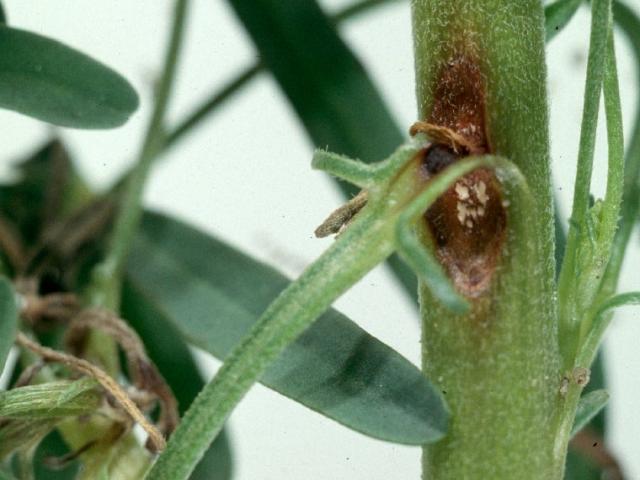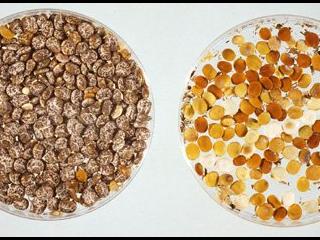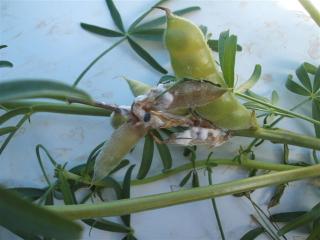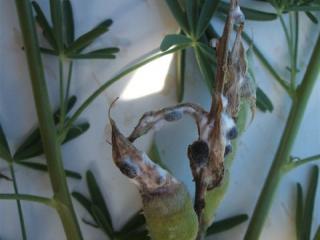Brown spot
Brown spot (Pleiochaeta setosa) is the most widespread foliar disease of lupins in Western Australia. Paddocks which have previously grown lupins will have Pleiochaeta spores in the soil. The disease can infect lupins at all stages of growth but seedling infection has the greatest impact on yield. Spores produced on dead tissue become incorporated into the surface layers of the soil where they can persist for several years, although under non-host crops the concentration reduces over time. Infection occurs when spores are splashed by rain from the soil onto new lupin plants. Factors which reduce the growth rate of plants such as colder environments, late sowing, poor nutrition, herbicide damage or unfavourable soil type, prolong exposure to rain-splash at the most susceptible seedling stage. All lupin species are affected although yellow lupins show resistance.
Symptoms
Infected cotyledons develop dark brown spots and rapidly become yellow and drop off. Leaves also develop dark brown spots, often net-like in appearance and can be distorted and reduced in size before prematurely dropping off. On stems, brown flecks may be evident, occasionally developing into large brown-black cankers which kill the stem above the infection point. Pods, particularly those set closer to the ground, may be flecked or develop larger brown lesions. Stem and pod infection are usually associated with leaf infection in the upper canopy.
Management
- Soil borne spore concentration diminishes under non-host crops, consequently longer rotations reduce risk of brown spot infection.
- Sowing lupin into retained cereal stubble reduces rain splash of soil-borne spores onto foliage.
- Application of iprodione or procymidone based seed dressing fungicides dramatically reduces seedling brown spot infection.
- Factors which promote seedling vigour and canopy closure such as early sowing, adequate nutrition, care in herbicide use, higher seeding rates and sowing onto favourable soils reduce disease impact.
- Small differences in brown spot tolerance exist between narrow-leafed lupin varieties but this does not remove requirement for other management approaches.
Anthracnose
Anthracnose (Colletotrichum lupini) is a fungal disease spread by infected seed and rain-splash of spores from infected plants. Stubble is not a major source of infection. All lupin species are affected, but generally albus lupin, yellow lupin and WA blue lupin are more susceptible than narrow-leafed lupin. Anthracnose is favoured by warm wet conditions and therefore the greatest risk of disease is in high-medium rainfall areas, particularly the northern agricultural region where blue lupins are abundant.
Symptoms
Anthracnose can infect all above-ground parts of the lupin plant, severe infection can lead to plant death. The most distinctive symptom is bending and twisting of stems with a lesion in the crook of the bend. Stem lesions are usually dark brown with a pale pinkish-orange spore mass within the lesion. The stem can be completely girdled by lesions or so weakened that it breaks. Both the main stem and lateral branches can be affected and close inspection will often show similar symptoms on leaf petioles. Pods develop lesions similar to stems and are often twisted and distorted. Infections at this stage can result in complete loss of pods or production of infected seed. Infected seeds can appear symptomless or can be malformed with discolouration, fungal mycelium or pink spores on the seed surface.
Management
- Resistant varieties are available; these should be used in higher risk environments.
- Seed can be tested for the presence and quantity of anthracnose infection. Use of clean seed is ideal but in some circumstances (for example, resistant varieties or lower rainfall environment) low levels of seed infection can be tolerated.
- Thiram-based seed dressing fungicide will reduce disease transmission from infected seed.
- Blue lupins are a common source of inoculum, if possible blue lupins should be destroyed or separation from susceptible varieties maintained.
- In high disease situations, registered foliar sprays applied at early podding on main stems and first order branches can be used to reduce yield loss.
Phomopsis stem and pod blight
Phomopsis stem and pod blight (Diaporthe toxica) occasionally causes yield losses, however the major impact of infection is the production of a mycotoxin (phomopsin) by the fungus as it grows in mature lupin stems or in seed. The toxin can cause sickness or death (lupinosis) in livestock if grazing of infected stubble is poorly managed. Spores released in winter from fruiting bodies on stubble infect growing lupin plants but rarely cause lesions at this stage unless plants are stressed by drought, herbicide or frost. The infection remains latent as microscopic structures until senescence of the plant tissue. Moisture, such as summer rain, on the mature infected tissue allows the fungus to grow saprophytically producing the mycotoxin and also new fruiting bodies.
Symptoms
Symptoms usually appear on senescing or dry lupin stems as dark purplish brown lesions which bleach with age and contain black fruiting bodies. Lesions can develop on pods, causing the surface of green pods to become ‘slimy’ and mature pods to be shrivelled with dark discolouration. Pod lesions can lead to seed infection, causing shrivelled seed or whole seeds with golden brown discolouration. Infected seed may also contain mycotoxin.
Management
- Variety resistance is the most effective way of reducing phomopsis.
- All current narrow leafed lupin varieties have moderate levels of resistance to stem and pod infection, although stem and pod resistance can be independent and may difffer within individual varieties.
- If weather conditions favour the pathogen (prolonged rainfall or high humidity in late spring and summer), stubble may still develop some toxicity requiring care with grazing, however usually current varieties do not produce highly toxic stubbles.
- Increasing breaks between lupin crops allows weathering and breakdown of infected stubble, reducing disease inoculum.
Cucumber mosaic virus (CMV)
Cucumber mosaic virus (CMV) is a seed and aphid-borne virus that infects lupins. Historically, high rainfall zones have had highest disease risk. Infected seed is the most important source of CMV for lupin crops. Plants grown from infected seed act as primary infection sources for aphids to acquire the virus and spread it to healthy plants within the crop.
Symptoms
Plants grown from infected seed are stunted with pale, bunched, down-curled, faintly mottled leaves. Plants infected by aphids during the season exhibit similar symptoms on plant parts that emerge following infection, older leaves present before infection remain healthy. Pod set and seed size are both reduced in infected plants.
Management
- Sowing healthy uninfected seed is the most effective way to reduce CMV occurrence in a crop.
- Virus spread can be reduced by promoting early canopy development with narrow row spacing and high seeding rates to shade out infected seedlings; and by sowing into retained stubble and minimising bare ground exposure to deter aphid landings.
- Varieties differ in their rate of seed transmission of this disease. Varieties with low seed transmission rates are recommended for high rainfall environments. Albus lupins are not hosts of CMV.
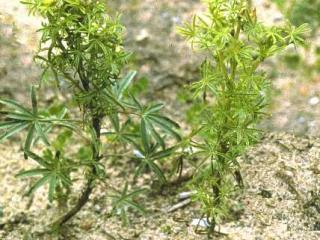
Bean yellow mosaic virus (BYMV)
Bean yellow mosaic virus (BYMV) causes a serious disease in lupins which is found predominantly in high rainfall wheatbelt zones It is not seed-borne in narrow-leafed lupins, but survives and builds up in clover pastures. It is transmitted from infected clover plants to lupin crops by aphids. Disease risk is usually highest in seasons with summer/autumn rain promoting early build-up and migration of aphids. Crops neighbouring clover based pastures or containing clover weeds are at greatest risk of infection.
Symptoms
In narrow-leafed lupins, symptoms start with necrotic streaking from the youngest shoot, which bends over causing a characteristic shepherds’ crook. The growing tip dies and the leaves become pale, wilt and fall off. Necrotic streaking and blackening then spread throughout the stem causing the plant to die. In later infections the necrotic symptoms may remain restricted to sections of the plant close to the site of infection and may cause black pods (black pod syndrome) and shrivelled seed on the main stem and affected branches. Dependent upon variety, Albus lupin can either express classical mottling and stunting symptoms or stunting and necrotic streaking similar to narrow leafed lupin.
Management
- Eliminate clover regrowth under lupin crops and avoid sowing adjacent to clover based pastures.
- Deter aphid landing by reducing bare ground exposure through promoting early canopy development and sowing into retained stubble.
- Differences are evident between varieties in expression of black pod symptoms associated with late BYMV infection.
Sclerotinia stem rot
Sclerotinia stem rot (Sclerotinia sclerotiorum) is a fungal disease which infects most broad leaf crop and pasture species but not cereals. It is most common in higher rainfall areas and usually affects plants after flowering in warm and damp conditions. Outbreaks of the disease are sporadic dependent on paddock history and seasonal weather conditions, often the disease affects only a percentage of the crop and the loss of yield is proportional to area infected. Crops with lush dense canopies in seasons with regular rainfall are at greatest risk, particularly when sown on paddocks with a history of sclerotinia infection in canola or lupins previously. In severe cases sclerotia become mixed with harvested seed which may incur extra cost of grading seed to remove them.
Symptoms
Predominantly lesions occur in the upper half of the main stem or branches and on flowers and pods. The fungus produces a white cottony-looking growth that girdles the stem, causing the plant parts above the lesion to wilt and die. Infected pods can be completely covered by this white fungal growth. Hard black sclerotia, 2-8 millimetres (mm) in diameter, are produced in the fungal growth or in the cavities of infected stems or pods. Sclerotia can survive in soil for several years and are the source of new infections.
Management
- Crop rotation can have some effect, although sclerotia survive for significant periods. Cereals are non-hosts and provide the most effective disease break.
- Avoid sowing lupins in close rotation with other broad leaf crop species, particularly canola.
Minor foliar diseases
Grey leaf spot (Stemphylium botryosum) causes brown circular lesions on leaves which with age can expand and become ash-grey often causing premature defoliation. Brown ‘pockmark’ lesions can occur on stems and pods. In severe cases complete defoliation can occur. Current varieties carry effective genes for resistance and the disease is uncommon in WA.
Cladosporium leaf spot (Cladosporium sp.) causes dark grey circular spots on flowers and leaves of lupin plants in warm and wet conditions. Drier spring conditions rapidly reduce disease spread and yield reductions rarely occur.
Grey mould (Botrytis cinerea) causes large sunken lesions on stems or branches and infects and causes abortion of flowers and pods. Mature lesions are characterised by grey, fuzzy mould. Favoured by warm humid spring conditions or dense crop canopies. This disease may be more common in albus lupins but rarely causes economic damage in WA lupin crops.
Powdery mildew (Erysiphe polygoni) affects all lupin species. Typically it is seen as a white powdery growth on leaves, stems and pods. Serious crop damage has not been reported in WA.



